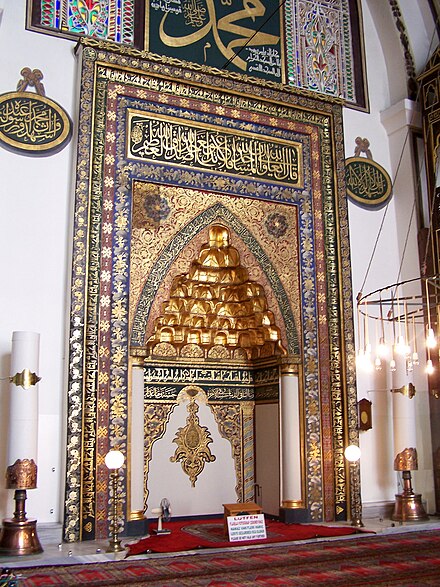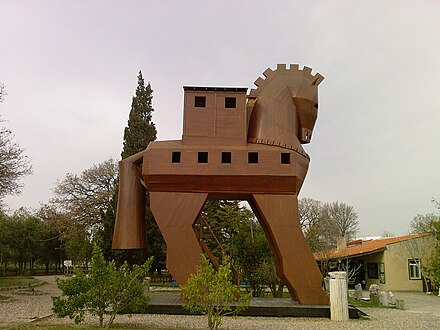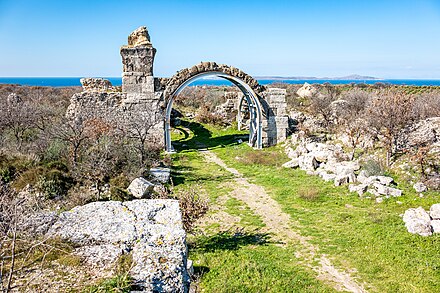Southern Marmara
Southern Marmara
Southern Marmara (Turkish: Güney Marmara) is the southern part of Marmara Region, Turkey.
Cities and towns
- Bursa is a big modern city, but as the first Ottoman capital it's full of historic sights.
- Mudanya is the ferry port linking Bursa to Istanbul.
- Gemlik is an industrial city at the head of the Gulf of Gemlik.
- Armutlu is a beach resort north of the Gulf, with geothermal springs.
- Bandırma is a port with fast ferries from Istanbul.
- Erdek is a family seaside resort.
- Gönen is a spa town with hot springs
- Balıkesir is mostly modern but has several old mosques.
- Sındırgı is noted for its rugs and _kilim_s.
- Çanakkale is the regional hub on the bank of the Dardanelles.
- Geyikli has ferries to Bozcaada. A few km south are the ruins of Alexandria Troas.
- Bozcaada 📍 in legend was where the Greek fleet hid before tricking their way into Troy.
Other destinations
- Troy 📍 was the target of the legendary Trojan Wars.
- Marmara Islands 📍 are a resort archipelago: Avşa has the most facilities.
- Bird Paradise National Park 📍 (Kuş Cenneti Milli Parkı) is a wildlife reserve south of Bandırma.
- Gölyazı is a village on a lake island linked by road. There are Roman and other antiquities and you can hire a rowing boat to plosh around the lake.
- Mount Uludağ 📍 is a national park and wintersports resort.
Understand
Southern Marmara is simply a geographical term, as is the larger Marmara region that it's part of. Turkish local government is in 81 provinces, with no intermediate level between them and national government, and those making up this area (more or less) are Çanakkale, Balıkesir and Bursa Provinces, with a little corner of Yalova. These have little relevance to travellers, so this page describes the large peninsula lying south of the Sea of Marmara, which also has a coastline on the Aegean. It's bordered by the similarly geographical, non-administrative regions of Eastern Marmara to the northeast and east, Central Anatolia southeast, Northern Aegean south, and Eastern Thrace north and west in Europe across the sea and the Dardanelles Strait.
The long coastline meant that sea-going Hellenistic people settled it in prehistoric times. The eastern two-thirds (roughly between Bursa and Balıkesir) was the kingdom of Mysia, while the western peninsula was Troad, "the plains behind Troy". Somebody ought to have mentioned this to the Greek warriors of legend, who (lacking a reliable internet travel guide), mistook Mysia for Troy, stormed ashore and poked King Telephus in a nasty place. Later he was good enough to point out to them just where Troy was.
The Ottoman dynasty began its long march to power when it captured Bursa in 1326, and went on to rule much of the east Mediterranean and southeast Europe. But it was a cosmopolitan affair, with large (sometimes majority) Greek-speaking populations in its coastal towns, along with Armenians, Jews and other traders. Interethnic tensions rose from the 19th century as the Ottoman empire crumbled. Turkey was defeated in the First World War and then was plunged into a follow-on war as Greece tried to seize more territory. The 1923 peace treaty meant the Greeks were deported from Turkey and vice versa. All the Aegean islands were awarded to Greece except Bozcaada in this region and Gökçeada further north.
In modern times the Southern Marmara region made a living from agriculture and associated industry, which burgeoned as roads improved and brought it within a few hours of Istanbul. It has a 2000 year history of tourism, which likewise developed, but it was almost all domestic tourism - mostly on the coast, but Mount Uludağ became a ski resort. Western visitors found their way to Gallipoli and Troy but not much beyond, and the big international beach resorts lie away south of this region.
Get in

- By air: international visitors will find it easiest to fly into one of the Istanbul airports and take the bus or hire a car. Yenişehir (IATA: YEI) and Çanakkale (IATA: CKZ) have flights from Ankara.
- By boat: fast ferries (foot passengers only) ply from Istanbul across the Sea of Marmara to Güzelyalı and Mudanya (for Bursa), and to Armutlu and Bandırma. Car ferries ply across the Dardanelles from Gelibolu, Eceabat and Kilitbahir on the European side to Çanakkale on the Asian bank.
- By road from Istanbul you can go either way around the sea. For western parts, 1915 Çanakkale Bridge and associated motorways opened in March 2022, soaring across the Dardanelles and cutting the 7-hour journey to Çanakkale down to 5 hours. For eastern parts, a motorway heads from Gebze to Bursa and beyond. Highway D550 / E87 follows the coast from Izmir via the Northern Aegean region to Troy and Çanakkale.
- Buses link all the major cities and Istanbul, and anywhere on the Istanbul-Izmir route has a frequent service, with price competition between operators. From Ankara take the high-speed train to Eskişehir then the connecting bus to Bursa.
- By train: a daily train trundles from Izmir via Balıkesir to Bandırma. One daytime and one overnight train run from Eskişehir via Kütahya to Balıkesir and Izmir. A high-speed railway is under construction towards Bursa.
- Two itineraries cross this region, taking in as many historic sites as you've time for:
- Along the Troad Coast from Çanakkale to Assos in the Northern Aegean region.
- Istanbul to Izmir between those major cities, with a leash of possible routes.
Get around
The indiviual cities can be explored on foot or by local bus (you can even travel from Bursa to Uludağ by cable-car), but you need your own wheels to tour the region.
The principal highway is O-7 / O-5 linking Gemlik, Bursa, and Balıkesir. The tolls are high but you'll save so much time and fuel by avoiding stop-starting through the towns.
E87 / D550 follows the Aegean coast north past Troy to Çanakkale. E90 / D200 heads along the Marmara coast from Çanakkale, with O-6 branching off over the Dardanelles bridge, while D200 continues east to Bandırma, Bursa and eventually Eskişehir.
See

- Çanakkale defended the Dardanelles and its castle is now a Naval Museum.
- Bursa was the first city the Ottomans captured, so it was their powerbase until they gained Edirne then Constantinople. They continued to embellish and repair Bursa, so it has a series of fine mosques and noble tombs, and stretches of its city walls still stand.
- Saraylar on Marmara Island was a marble quarry in Roman times, and is dotted with unfinished sculptures and funerary monuments.
- Bird Lake (Kuşcenneti) is a wildlife reserve south of Bandırma.
- Zagnos Pasha Mosque is the best of those in Balıkesir.
- Troy in legend was the target of the Trojan Wars. The remains are limited - you won't find fluted Grecian columns here - but the museum is impressive.
- Alexandria Troas near Geyikli may have been even greater than Troy, though the site is overgrown.
- Bozcaada is an inhabited island with a harbour castle and old Greek villages.
Do

- Hot springs gush out in many areas, such as Kestanbol near Geyikli and in the Çekirge district of Bursa.
- Uludağ is a ski resort, with reliable snow cover from Dec to March.
- Lots of beach resorts on the Marmara coast, including the island of Avşa. There's little on the Aegean coast, which is rugged this far north.
- Green-Blue Road (Yeşil-Mavi Yol) is a switchback scenic road along the peninsula between Armutlu and Çınarcık near Yalova. Picnic in the woods, or plumb the depths of the two Bottomless Lakes.
Eat
- All the Turkish and East Med staples - there's not much cosmopolitan cuisine outside Istanbul.
- Fish is the main offering at the beach restaurants, but it may have been shipped a long distance to reach your plate.
Drink

- Beer, wine and rakı is served in most cafes.
- Some wine is grown locally, although the main area is north of the sea around Şarköy.
Stay safe
- Standard advice about road traffic and care of valuables. In winter there can be heavy snowfalls even at low altitude.
- Bears lurk in the fastnesses of Mount Uludağ above Bursa, but you're more at risk from illegal bear traps.
Go next
- Eastern Thrace is the European part of Turkey, linked by bridge and ferry across the Dardanelles. Edirne is the highlight, and Eceabat has the Gallipoli memorials.
- Eastern Marmara is mostly industrial sprawl, but Iznik, scene of the First Ecumenical Council in 325 AD, has preserved its ancient layout.
- Northern Aegean region is best known for its beach resorts, but the Graeco-Roman ruins at Bergama are outstanding.
- Istanbul is unmissable.